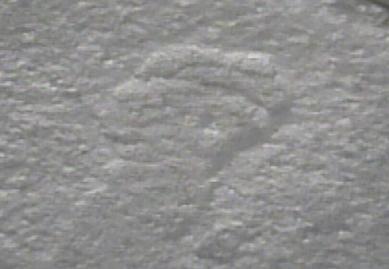Experiment gives unintended results
While trying to produce hanging dendritic features, like those found on Mars,
a larger group of features was produced,,, including alcoves and interward ridge features.
But a surprise came when Electro-Mass-lifting
created many features simultaneously.

At another page I began to offer evidence from experiments, using a CRT surface, in an efforts to replicate dendritic patterns found within Valles Marineris and at many other land-forms found around Mars. Those experiments involved a variety of setups with the CRT, each providing examples of electro-dynamic behavior that may offer clarity toward the dynamic of electrical interactions.. With those results in mind i changed setups, taking the CRT's screen out and using just a base-plate and large probe,, connected to power supplies.The results of all setups revealed that different electrical interactions can leave
sharp cut rims, alcoves, hanging remnants and flattened floors as material is scavanged from the surface to be 'deposited' elsewhere, such as the probe,, or just ejected entirely. The most pronounced detail observed was the excabations that occurred during pre-arc interaction. One setup showed this clearly as dishes of material were prepared and exposed to the electrical forces of a large probe which was moved across the base-plate with approaching and departing motion,, with separation sufficiant to terminate any interaction..
Two different power sources were used: An air ionizer with connections adapted to a base-plate and to the probe; the other power source was a 12volt fly-back transformer,,, which produced the best results, both with loose material and with dishes of material prepared with salt-water treated that was allowed to dry somewhat or thoroughly..
to dry somewhat or thoroughly.
When dry material was engaged the dynamics was quite extreme but revealing of the behavior of the electrical interaction, see 2017 videos for additional examples..
We've seen previously the formation of alcoves and interior radial features during much earlier experiments at lower power levels and thinner material, so with these experiments a pattern is growing.
Electrical excavation of material often leaves alcoves & radial features tracking inward within the primary feature,, either craters or trenches.
These experiments involved varying depths of material, each suited to whatever power and probe arrangement being used. Best result were obtained with a firmly supported large-sphere probe which was rotated smoothly across the base-plate, changing height as needed to coax interaction.. When treated-and-dried thick material was engaged, it resisted the electrical forces up to a point.. Beyond that point, i've seen that large chunks of material can be lifted from the surface during the dark-mode interaction phase, which is likely the non-visible phase when corona activity would be expected, [also described as electric wind, when at much lower intensities]. The stresses of the interaction lifts material leaving trenches of varying widths, as can be seen in the first row of images below.
An important detail to realize is that arcs wouldn't readily penetrate the material of this depth. If one did, it would leave a very small entry feature,
and when the probe was moved, the arc would stick and jump with consistant spacing. The occurrance of mass electro-lifting seemed to happen when long probe distances and thick material depths were present, an arc couldn't be readily established, but interaction was visible as particulates were agitated.
Large scale removal of material, to form the trenches or clearing of material as seen in the right image, was the work of invisible electrical forces that preceded the arc. This electrical effect was also seen in earlier experiments with an ionizer providing power.
Its output power was different than the fly-back transformer,, which was dangerous,, even at 12volt supply to the primary windings.. Polarity was not identified or voltage measured with ither setup.
The soil used, for the features below, was clay-like, taken from a road-cut through a redish hill in east-central Arizona..
At left, in this second row, is an image from the ionizer-powered experiment.
The ball-end of this trench was the result of electro-lifting of a mass of material.
In the video (tyuyW3syhPU) it looked like tossing chips of dirt, as did the images above.
The center image shows that the lifting stopped when the arc began. Mass-lifting cleared material to form the trench and and when the probe approach thinner material the lifting stopped because the arc caused concentration of energy rather than a broad stressful electrical interaction in dark mode.
The right image shows parallel features running at right angle to a remnant rim, consistant with excavation forces seen in off-axis corona experiments.
3D image for side-by-side viewing

Compare the images above to a Mars image claimed by some to be the result
of sculpting by a "traveling electric-arc"...
http://www.thunderbolts.info/wp/2012/11/16/electric-sculpting/

^<<<< Mars side --- Experiments side >>>^
Electro Mass-lifting was seen to tear large chuncks from the surface,
which exposed the surface below, and then a few visible arcs left their mark across the flat
floored trench.




